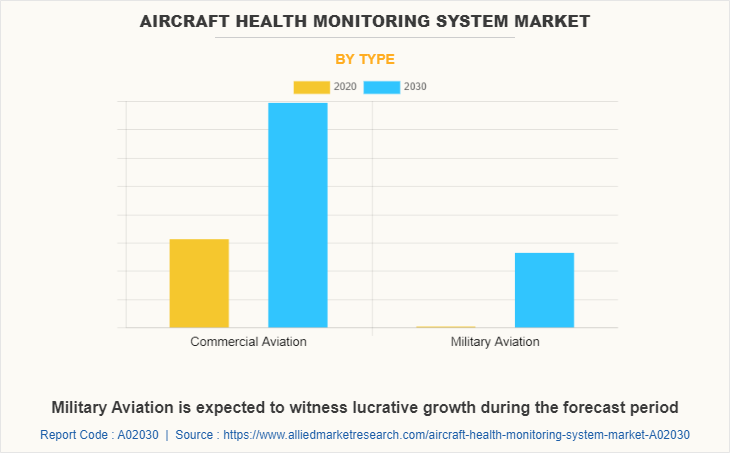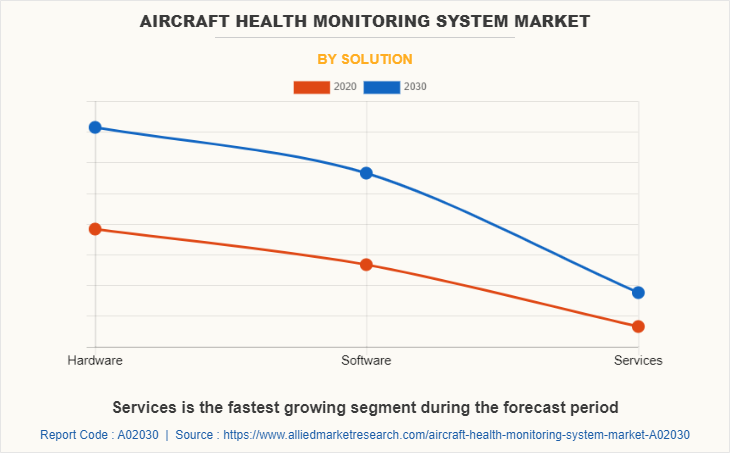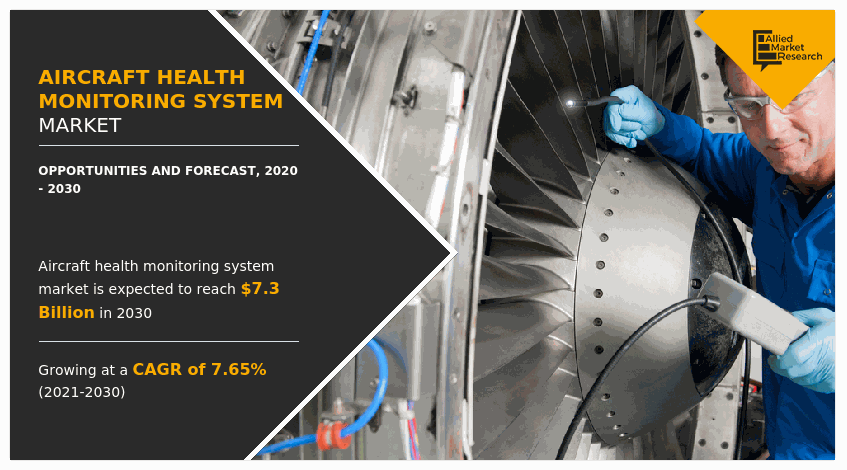Aircraft Health Monitoring System Market Research, 2030
The global aircraft health monitoring system market was valued at $3,580.02 million in 2020, and is projected to reach $7,273.84 million by 2030, growing at a CAGR of 7.65% from 2021 to 2030.An aircraft health monitoring system (AHMS) is a software and hardware system that includes, sensors and other highly networked processing units for remote monitoring of airplane data to assess its future or current serviceability and performance. These systems are also known as aircraft condition monitoring systems (ACMS). An aircraft health monitoring system (AHMS) is directly related to the airline industry's maintenance, repair, and overhaul (MRO) segment. The use of an AHMS decreases maintenance and operational costs while also improving an aircraft's overall safety.
Increase in demand for real-time problem management, custom alerting & analysis solutions, and rise in demand for performance monitoring drive the growth of the aircraft health monitoring system market. Furthermore, rise in aerospace IT investment in emerging economies and technical improvements for workflow optimization, increase the demand for advanced analytical systems, thus driving market growth.
However, lack of qualified specialists is projected to stifle future expansion. On the contrary, increase in application areas for aircraft integrated vehicle health management (IVHM) is likely to open up attractive opportunities for the aircraft health monitoring system market.

The aircraft health monitoring system market is segmented on the basis of type, solution, end user, aircraft type and region. By type, the market is categorized into commercial aviation and military aviation. On the basis of solution, the market is divided into hardware, software, and services. On the basis of end user, the market is divided into OEMs, MRO, and airlines. On the basis of aircraft type, it is categorized into fixed wing aircraft and helicopter. The market is analyzed based on four regions, namely North America, Europe, Asia-Pacific, and LAMEA.
Key players profiled in this aircraft health monitoring system market report include Airbus, Honeywell International Inc, FLYHT Aerospace Solutions Ltd., General Electric, Meggitt PLC, Rolls-Royce PLC, RSL Electronics Ltd, Raytheon Technologies Corporation, Teledyne Controls LLC., and The Boeing Company.

High demand for decision support systems
The primary role of aviation maintenance is to prevent the diminished levels of original aircraft airworthiness, reliability design, and safety at minimal cost, which is of great significance to air transport enterprises. The development of the aviation industry in recent years has increased the complexity of aviation maintenance. Increase in use of aircraft for traveling and defense purposes generates the need for advanced maintenance systems, which gives rise to the demand for decision support systems. There are three types of decision support systems:
Real-Time Fault Management - With the use of this system, when the airplane is still enroute, in-flight faults are communicated to the airline operation center and OEM (Original Equipment manufacturers) operations center for diagnosis. This allows aircraft operators to make real-time operational decisions about maintenance.
Performance Measurement – AHM analyzes airplane performance facts to support airplane fuel efficiency initiatives and optimizes flight planning. This system includes prioritized information related to fuel efficiency, emission level, and other factors related to operational performance.
Customer Alerting and Analysis – This helps address airplane system issues for customer-specified monitoring and alerting of the data transmitted from the airplane. With the use of ACARS (Aircraft Communications Addressing and Reporting System) through the installed Aircraft Condition Monitoring System (ACMS), AHM automatically gathers, monitors, and transmits analyzed data. The system tracks consumption patterns to help with maintenance planning and recognizes optimal service intervals.
Increase in demand for advanced data analytics
The advanced aviation industry mainly faces problems, such as inappropriate business decisions due to the unavailability of data management systems, maintenance scheduling, business/operation trend analysis, Aircraft on Ground (loss of revenue), and others. These problems are efficiently solved with the use of advanced data analytics software for maintenance operations. Companies have begun to develop new support systems for aircraft health monitoring to facilitate real-time, post-flight recorded data management, fault notification, and diagnostic reporting. These new developments drive the aircraft health monitoring system market.
Moreover, the need for passenger satisfaction and safety has initiated the need for advanced infrastructure development in the aviation industry. Also, rise in defense budgets and increase in R&D for defense aircraft, increase the complexity of aircraft, and therefore generate more complexity in maintenance services. Many airlines companies have started adopting aircraft health monitoring systems to provide maintenance services, for which advanced techniques, such as real-time fault management are required. For instance, In November 2021, SAUDIA signed an agreement with The Boeing Company. Under this agreement, SAUDIA is expected to utilize Boeing’s Optimized Maintenance Program (OMP), and Airplane Health Management (AHM) digital solution. In October 2021, Scandinavian Airlines signed a contract with Airbus. Under this contract, Scandinavian Airlines selected Airbus' Skywise Health Monitoring (SHM) digital solution for the fleet. These adoptions of aircraft health monitoring systems fuel the growth of the aircraft health monitoring system market.
Dearth of trained professionals
New developments in aircraft health monitoring systems have generated complex systems. With the aircraft health monitoring system market being in the growth stage of the product life cycle, there exists a lack of trained professionals that limits end users to invest in advanced solutions and services. However, with increase in use of advanced aircraft health monitoring systems and rise in awareness about aircraft health monitoring systems, the impact of this factor is projected to decrease in near future, due to the availability of trained professionals.
Growth of integrated vehicle health management (IVHM)
Integrated vehicle health management (IVHM) system collects and analyzes data of operating parameters and damage information of the vehicle in real-time. The ongoing research in IVHM developed a new IVHM system that is lightweight, small, and capable of withstanding the vehicle’s operating conditions & environment, easily networks the information to onboard preprocessing units, needs low power input, and makes way for increased accuracy. New technology is a development trend associated with next-generation aircraft Conditional Based Monitoring (CBM). Integrated health management for airplanes strongly influences the maintenance efficiency of civil fleets, military fleets, and drone fleets. The leading companies of the industry, such as Boeing and Airbus have invested in IVHM research. For instance, in March 2020, Boeing joined the $79.76 million (£65 million) Digital Aviation Research and Technology Centre (DARTeC) at Cranfield University of Europe by Integrated Vehicle Health Management (IVHM) Center. The Integrated Vehicle Health Management (IVHM) Centre is a collaborative effort between industries and universities to develop cutting-edge technologies that will transform how services are delivered in the future. Through DARTeC, the IVHM Centre will be leading the MRO (maintenance, repair, and overhaul) developments and activities with expertise and capabilities in UAV robotics NDT inspections, SHM sensor monitoring, and advanced digital technologies, such as artificial intelligence (AI) and digital twins (DT), tools that could be used to synchronize, monitor, and improve all processes related to aircraft MRO.

Key Benefits For Stakeholders
- This report provides a quantitative analysis of the market segments, current trends, estimations, and dynamics of the aircraft health monitoring system market analysis from 2020 to 2030 to identify the prevailing aircraft health monitoring system market opportunities.
- The market research is offered along with information related to key drivers, restraints, and opportunities.
- Porter's five forces analysis highlights the potency of buyers and suppliers to enable stakeholders make profit-oriented business decisions and strengthen their supplier-buyer network.
- In-depth analysis of the aircraft health monitoring system market segmentation assists to determine the prevailing market opportunities.
- Major countries in each region are mapped according to their revenue contribution to the global market.
- Market player positioning facilitates benchmarking and provides a clear understanding of the present position of the market players.
- The report includes the analysis of the regional as well as global aircraft health monitoring system market trends, key players, market segments, application areas, and market growth strategies.
Aircraft Health Monitoring System Market Report Highlights
| Aspects | Details |
| By Type |
|
| By Solution |
|
| By End User |
|
| By Aircraft Type |
|
| By Region |
|
| Key Market Players | General Electric, The Boeing Company, Honeywell International Inc., Raytheon Technologies Corporation, Meggitt PLC, Airbus, Flyht Aerospace Solutions Ltd., Rolls-Royce PLC, RSL Electronics Ltd, Teledyne Controls LLC |
Analyst Review
The utilization of aircraft health monitoring systems among varied aircraft types has increased due to rise in safety concerns among the aviation & defense sector and reduction in operational & maintenance costs for varied operations. Moreover, increase in aerospace spending, rise in demand for real-time conditional updates, and growth associated with the commercial aviation industry drive the growth of the market. In addition, recent innovations in advanced real-time solutions further fuel the market growth.
Moreover, increase in the economic strength of developing nations, such as China, India, Indonesia, Thailand, and others is expected to provide lucrative opportunities for the market. Asia-Pacific is expected to dominate the market during the forecast period and emerging countries in Asia-Pacific and Latin America are projected to offer significant growth opportunities.
Furthermore, many airlines adopted aircraft health monitoring systems due to R&D related to technologies used in aircraft health monitoring systems, which are expected to help enhance the efficiency of airlines. For instance, in 2021, the Middle East Airlines signed an agreement with Airbus to join a community of Skywise Health Monitoring (SHM) users. In October 2021, Scandinavian Airlines signed a contract with Airbus. Through this contract, Scandinavian Airlines selected Airbus' Skywise Health Monitoring (SHM) digital solution for fleet.
The aircraft health monitoring system market is segmented on the basis of type, solution, end user, aircraft type and region. By type, the market is categorized into commercial aviation and military aviation. On the basis of solution, the market is divided into hardware, software, and services. On the basis of end user, the market is divided into OEMs, MRO, and airlines. On the basis of aircraft type, it is categorized into fixed wing aircraft and helicopter. The market is analyzed based on four regions, namely North America, Europe, Asia-Pacific, and LAMEA.
Key players profiled in this report include Airbus, Honeywell International Inc., FLYHT Aerospace Solutions Ltd., General Electric, Meggitt PLC, Rolls-Royce PLC, RSL Electronics Ltd., Raytheon Technologies Corporation, Teledyne Controls LLC., and The Boeing Company
[REGIONGRAPH]
The global aircraft health monitoring systems market valued at $3.58 billion in 2020, and is projected to reach $7.27 billion by 2030, registering a CAGR of 7.65% between 2021 and 2030
An increase in the adoption of connected aircraft solutions
The report sample for global aircraft health monitoring systems market report can be obtained on demand from the website
Yes, driven by factors such as high demand for decision support systems and increase in demand for advanced data analytics, the aircraft health monitoring systems are being installed across all aircraft types globally
Aircraft health monitoring system (AHMS) is a group of activities, which includes data collection and analysis techniques used to ensure availability, reliability, and safety of aircraft
The company profiles of the top players of the market can be obtained from the company profile section mentioned in the report. This section includes analysis of top ten player’s operating in the industry along with their last three-year revenue, segmental revenue, product offerings, key strategies adopted, and geographical revenue generated
By end user, the MRO segment held the highest market share in 2020
The leading companies operating in the aircraft health monitoring systems market are Airbus, Flyht Aerospace Solutions Ltd., General Electric, Honeywell International Inc., Meggitt PLC, and Raytheon Technologies Corporation
Loading Table Of Content...



